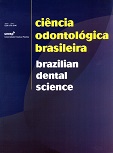O efeito da temperatura de queima da camada de opaco na resistência flexural de uma cerâmica vítrea submetida à cocção sobre uma liga de cobalto-cromo
DOI:
https://doi.org/10.14295/bds.2009.v12i4.650Abstract
Este estudo avaliou a influência da temperatura de queima da camada de opaco na resistência de união entre uma liga de cobalto-cromo e uma cerâmica, após serem submetidos ao ensaio de flexão de três pontos. Considera-se a hipótese: o aumento da temperatura de queima do opaco melhora a resistência flexural da cerâmica aplicada sobre o metal. Barras metálicas (25x3x0,5mm) (n=30) foram fundidas em Co-Cr e as áreas centrais das barras (8x3mm) foram jateadas com partículas de óxido de alumínio de 150μm e divididas em 3 grupos de acordo com a temperatura de queima da camada de opaco (n=10): G1 (grupo controle) – 900°C; G2 – 950°C e G3 – 1000°C. As cerâmicas opaca e de corpo (Vita Omega 900) foram queimadas sobre a área central. Os espécimes foram mantidos em água destilada à 37° C durante 24 horas e a seguir foram submetidos ao teste de flexão de três pontos. Após o teste, os tipos de falhas foram classificados. Os dados obtidos foram analisados estatisticamente (Kruskal-Wallis 1 e teste de Dunn , μ=0,05). A diferença dos valores médios de resistência flexural foi estatisticamente significante (p=0,004), sendo que os grupos G2- 19,84±4,24N e G3- 22,43±5,94N exibiram valores de resistência flexural maiores que o grupo G1- 12,525±1,08N. Concluíu-se que o aumento da temperatura de queima da camada de opaco melhorou significantemente os valores de resistência flexural. O modo de falha predominante foi adesiva na interface metal/cerâmica para o grupo G1 e exclusivamente coesiva na zona interfacial camada de opaco/Co-Cr com presença de cerâmica na superfície dos grupos G2 e G3.
Downloads
Downloads
Published
How to Cite
Issue
Section
License
Brazilian Dental Science uses the Creative Commons (CC-BY 4.0) license, thus preserving the integrity of articles in an open access environment. The journal allows the author to retain publishing rights without restrictions.
=================




























